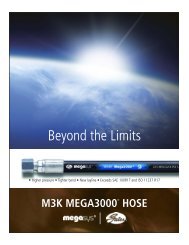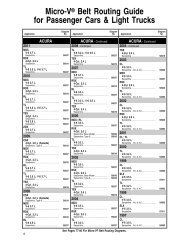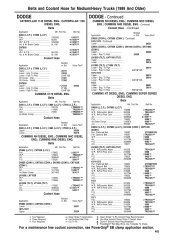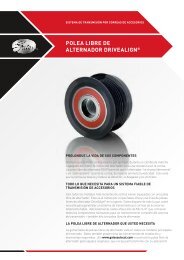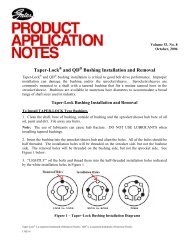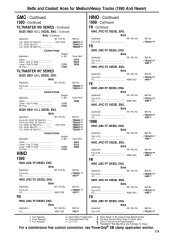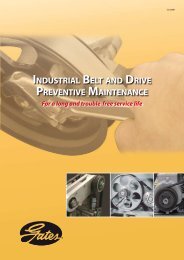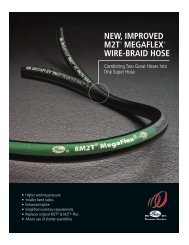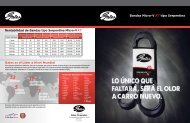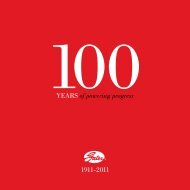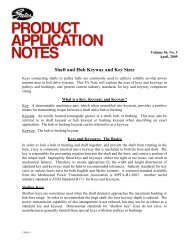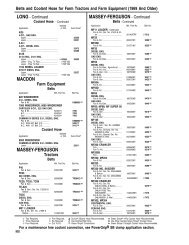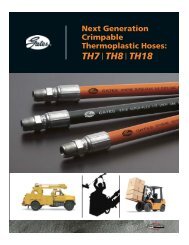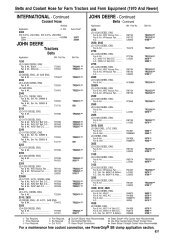PowerGrip® GT® Belt Drives
PowerGrip® GT® Belt Drives
PowerGrip® GT® Belt Drives
Create successful ePaper yourself
Turn your PDF publications into a flip-book with our unique Google optimized e-Paper software.
Polyflex ® JB ® and Micro-V ® <strong>Belt</strong>s – Engineering<br />
I. Operating Characteristics–continued<br />
Micro-V belts can be prone to slippage when<br />
installed with less than adequate tension, or when<br />
operating on a drive system with flexing centers.<br />
This potential slippage can result in noise. See<br />
Section IV. <strong>Belt</strong> Tensioning on Page 78.<br />
In many cases the belt drive system is not the<br />
primary cause of noise. Undersized, poorly<br />
lubricated, worn or misaligned bearings can cause<br />
significant noise levels. Rotating parts of a total<br />
system can create air movement patterns that<br />
generate noise. A weak structure could flex under<br />
the load and cause misalignment and affect<br />
components in the drive system, thereby creating<br />
noise. Also, make sure that the total system has not<br />
been designed into an echo chamber, amplifying an<br />
otherwise insignificant noise.<br />
D. Static Conductivity<br />
Polyflex JB belts do not meet the static-conductive<br />
requirements specified in RMA Bulletin IP-3-3. This<br />
bulletin describes those belt characteristics<br />
necessary for safe operation in potentially explosive<br />
or flammable environments. However, laboratory<br />
testing confirms that under dynamic operating<br />
conditions, Polyflex JB belts are nonstatic<br />
generating. Under normal operating conditions,<br />
Polyflex JB belts do not build up significant static<br />
charge.<br />
When Polyflex JB belts are used in explosive or<br />
flammable environments, additional steps must be<br />
taken to protect against accidental static spark<br />
discharges:<br />
(1) The entire system must be properly grounded.<br />
(2) A static conductive brush or similar device is<br />
recommended to bleed off any static buildup on<br />
the belt if it should occur.<br />
The nonstatic generating characteristics apply to<br />
new, clean belts. It is the user’s responsibility to<br />
establish an effective preventive maintenance<br />
program to monitor equipment and to replace or<br />
repair components, as needed, for continued safe<br />
operation.<br />
Micro-V belts do meet the static conductive<br />
requirements specified in RMA Bulletin IP-3-3<br />
describing the characteristics necessary for safe<br />
operation in potentially explosive or flammable<br />
environments. This applies to new clean belts. <strong>Belt</strong><br />
conductivity properties can be influenced by age<br />
and environmental debris.<br />
E. Operating Environments<br />
Caution should be used when installing Polyflex JB<br />
and Micro-V belt drives where debris is present.<br />
Debris can damage belts by becoming wedged<br />
between the belt’s strands, causing damage or<br />
separation. Debris can also cause belts to become<br />
unstable and turn over. If the drive must operate in<br />
this type of environment, be sure to provide<br />
adequate shielding.<br />
Since Polyflex JB belts use a 60° angle system, the<br />
coefficient of friction between the belt and sheave is<br />
extremely important. Any substance which<br />
decreases the coefficient of friction can cause belt<br />
slip. If the belt slips excessively, enough heat may<br />
be generated to cause catastrophic failure.<br />
Environmental contamination can also cause Micro-<br />
V belts to slip.<br />
Polyflex JB belt performance is generally unaffected<br />
in ambient temperature environments between<br />
-65°F and +185°F (-54°C and +85°C). Micro-V<br />
belts are capable of operating between -30°F and<br />
+180°F (-34°C and +82°C). Contact Gates<br />
Application Engineering if the drive must operate in<br />
temperatures that exceed these limits.<br />
II. Calculating<br />
Speed Ratio<br />
Nominal pitch is satisfactory for use in speed<br />
calculations on most drives. Most machines do not<br />
require exact driveN speeds to operate efficiently,<br />
and speeds vary because the speed of common<br />
driveR machines usually varies by several percent.<br />
For example, the speed of an ordinary induction<br />
type electric motor varies with load and line voltage.<br />
Speed ratio may be determined by the following<br />
formula:<br />
DriveN Pitch Diameter<br />
Speed Ratio =<br />
DriveR Pitch Diameter<br />
Find the pitch diameters of the sheaves by adding<br />
the appropriate factor listed in Table 32 on Page 71<br />
to the sheave outside diameters.<br />
The World’s Most Trusted Name in <strong>Belt</strong>s, Hose & Hydraulics.<br />
77



